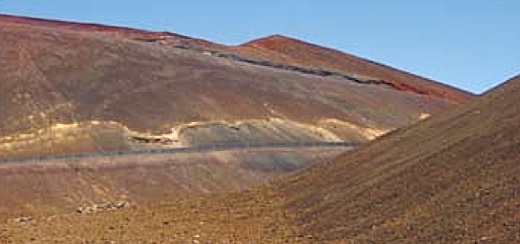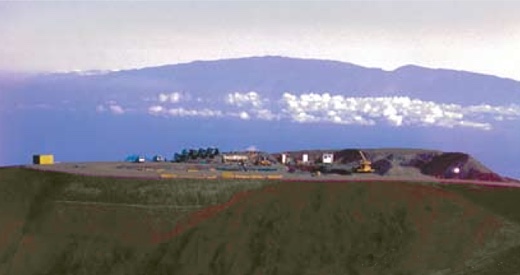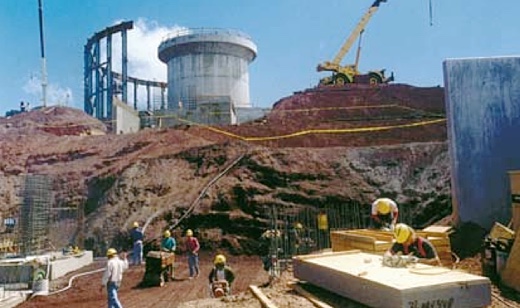SUBHEAD: Significant scarring and erosion of the Mauna Kea summit as well as threats to delicate habitats.
By Nelson Ho on 1 July 2015 for Malama i ka Honua -
(http://sierraclubhawaii.org/pdf/Sierra%20Club%20Newsletter%20JULY%202015%20Email.pdf)

Image above: Current scarring of summit ridge by erosion along access roadway to observatory sites. From original article.
Mauna Kea has garnered significant media and celebrity attention over the past few months, but the Sierra Club has had its eyes focused on the summit for decades.The controversy over telescope development atop Mauna Kea actually began with the first University of Hawaii facility in the 1968. From the start, the Sierra Club and the broader environmental community were key critics of development on and around the summit.
It was Club member Mae Mull, a Volcano resident and energetic environmentalist, who brought her concerns to this author’s attention, back in 1980. She was recruiting anyone who could make the arduous trip to the summit and speak for the Hawaii Audubon Society or Sierra Club.
Through numerous meetings, Mull made allies among the hunters concerned about access to hunting areas, which the Honolulu-based Institute for Astronomy attempted to limit. Mull kept boxes of newspaper clippings and documents from the many DLNR hearings back then. She was very vocal
about the urbanization of the summit as telescopes began sprouting up like weeds.
Her opinion was shared by many islanders upset with the proliferation of domes. Even Hawaii County Mayor Herbert Matayoshi called them “pimples” blemishing the beauty of the mountain.
During the late1970s Mauna Kea’s upper slopes were the testing ground for a series of moon vehicles. The field activities were reported in a 1979 issue of Science magazine. The article claimed that the volcano’s harsh stone environment was as bare and lifeless as the surface of Mars. Three Hawaii biologists scoffed at that superficial pronouncement and began their own field surveys to see what biology actually was on Mauna Kea.

Image above: Excavation in 1986 for the Keck facility on of Mauna Kea required 40 foot deep removal of summit material to make large enough area for construction. From original article.
Dr. Frank Howarth was an entomologist working at the Bishop Museum who specialized in cave biology. Dr. Wayne Gagne was an entomologist and a key volunteer leader on the Sierra Club of Hawaii’s Chapter Executive Committee. Dr. Steve Montgomery was the third entomologist in this group and was also very active on the Executive Committee. Howarth, Gagne, and Montgomery were friends of Bill and Mae Mull.
Together this volunteer team explored the alpine, aeolian (wind-driven) stone desert ecosystem. In 1979, they discovered a complex web of life, finding 15 species of native arthropods, including the endemic wekiu bug, nysius wekiucola, found nowhere else on the planet.
The wekiu bug is adapted to a habitat limited to the upper reaches of the Mauna Kea conservation district. This complex ecosystem, to this day, has not been studied, monitored nor protected from the industrial changes to the summit region.
Howarth and Dr. Fred Stone conducted an entomology study for the proposed Keck telescope area in 1982, and by the next year they were disturbed by the damage done to the summit habitat. They made recommendations for biological inventory, habitat mitigation, and monitoring. The wekiu bug habitat is easily altered by vehicular traffic and construction activity, as tephra cinders preferred by the bug are easily crushed into dust-sized particles, which fill their living spaces.
Prime habitat can be quickly degraded to compacted silt and mud by use of off-road vehicles. wekiu habitat may also be altered by dust blown up from road grading and other construction activities. Concerns about the urbanization and industrialization of the summit prompted the University to prepare a master plan in 1983. The University has still not fulfilled some of the promises made in that plan two decades ago.
Club members Deborah J. Ward and the author accompanied Dr. Fred Stone on a visit to the summit. The Japanese Subaru facility had seriously altered the top and inner cinder slopes of Puu Hauoki and was that day trenching, with heavy machinery, into the outer slopes of the cone (high-quality wekiu bug habitat) for optical and electrical cables. The DLNR had no idea this industrial activity was going on, let alone in prime wekiu habitat.

Image above: Excavation into cinder slope for construction of Japan's Subaru facility. From original article.
Was this the kind of activity and lack of oversight that Gov. David Ige and UH President Dave Lassner apologized for on May 26, 2015?
In 1996, the Sierra Club of Hawaii adopted a policy calling for;
The Sierra Club’s concerns back then—and today—include the visual impact of construction on sensitive cultural view planes from both the summit and the lowlands, the industrialization of conservation district land, the impact on cultural resources and historic sites, the impact on wekiu habitat, and the failure of the State to collect the fair market value of lease rents from foreign and mainland entities thatuse public trust lands.
The Sierra Club of Hawaii intervened in two contested case hearings: expansion of the Keck telescope facilities and the UH Comprehensive Management Plan.
For decades, Sierra Club has worked side by side with the Conservation Council for Hawaii and KAHEA: The Hawaiian-Environmental Alliance to correct bad land-use management practices for this vulnerable land. It also challenged the acceptance of the latest management plan.
.
By Nelson Ho on 1 July 2015 for Malama i ka Honua -
(http://sierraclubhawaii.org/pdf/Sierra%20Club%20Newsletter%20JULY%202015%20Email.pdf)

Image above: Current scarring of summit ridge by erosion along access roadway to observatory sites. From original article.
Mauna Kea has garnered significant media and celebrity attention over the past few months, but the Sierra Club has had its eyes focused on the summit for decades.The controversy over telescope development atop Mauna Kea actually began with the first University of Hawaii facility in the 1968. From the start, the Sierra Club and the broader environmental community were key critics of development on and around the summit.
It was Club member Mae Mull, a Volcano resident and energetic environmentalist, who brought her concerns to this author’s attention, back in 1980. She was recruiting anyone who could make the arduous trip to the summit and speak for the Hawaii Audubon Society or Sierra Club.
Through numerous meetings, Mull made allies among the hunters concerned about access to hunting areas, which the Honolulu-based Institute for Astronomy attempted to limit. Mull kept boxes of newspaper clippings and documents from the many DLNR hearings back then. She was very vocal
about the urbanization of the summit as telescopes began sprouting up like weeds.
Her opinion was shared by many islanders upset with the proliferation of domes. Even Hawaii County Mayor Herbert Matayoshi called them “pimples” blemishing the beauty of the mountain.
During the late1970s Mauna Kea’s upper slopes were the testing ground for a series of moon vehicles. The field activities were reported in a 1979 issue of Science magazine. The article claimed that the volcano’s harsh stone environment was as bare and lifeless as the surface of Mars. Three Hawaii biologists scoffed at that superficial pronouncement and began their own field surveys to see what biology actually was on Mauna Kea.

Image above: Excavation in 1986 for the Keck facility on of Mauna Kea required 40 foot deep removal of summit material to make large enough area for construction. From original article.
Dr. Frank Howarth was an entomologist working at the Bishop Museum who specialized in cave biology. Dr. Wayne Gagne was an entomologist and a key volunteer leader on the Sierra Club of Hawaii’s Chapter Executive Committee. Dr. Steve Montgomery was the third entomologist in this group and was also very active on the Executive Committee. Howarth, Gagne, and Montgomery were friends of Bill and Mae Mull.
Together this volunteer team explored the alpine, aeolian (wind-driven) stone desert ecosystem. In 1979, they discovered a complex web of life, finding 15 species of native arthropods, including the endemic wekiu bug, nysius wekiucola, found nowhere else on the planet.
The wekiu bug is adapted to a habitat limited to the upper reaches of the Mauna Kea conservation district. This complex ecosystem, to this day, has not been studied, monitored nor protected from the industrial changes to the summit region.
Howarth and Dr. Fred Stone conducted an entomology study for the proposed Keck telescope area in 1982, and by the next year they were disturbed by the damage done to the summit habitat. They made recommendations for biological inventory, habitat mitigation, and monitoring. The wekiu bug habitat is easily altered by vehicular traffic and construction activity, as tephra cinders preferred by the bug are easily crushed into dust-sized particles, which fill their living spaces.
Prime habitat can be quickly degraded to compacted silt and mud by use of off-road vehicles. wekiu habitat may also be altered by dust blown up from road grading and other construction activities. Concerns about the urbanization and industrialization of the summit prompted the University to prepare a master plan in 1983. The University has still not fulfilled some of the promises made in that plan two decades ago.
Club members Deborah J. Ward and the author accompanied Dr. Fred Stone on a visit to the summit. The Japanese Subaru facility had seriously altered the top and inner cinder slopes of Puu Hauoki and was that day trenching, with heavy machinery, into the outer slopes of the cone (high-quality wekiu bug habitat) for optical and electrical cables. The DLNR had no idea this industrial activity was going on, let alone in prime wekiu habitat.

Image above: Excavation into cinder slope for construction of Japan's Subaru facility. From original article.
Was this the kind of activity and lack of oversight that Gov. David Ige and UH President Dave Lassner apologized for on May 26, 2015?
In 1996, the Sierra Club of Hawaii adopted a policy calling for;
“a moratorium on any further development in the Mauna Kea Science Reserve until... [certain] conditions, designed to re-establish a prudent balance between astronomy and the cultural, religious, biological, eological, and recreational attributes of the mountain, are met...”To date, most of the conditions have not been satisfactorily met.
The Sierra Club’s concerns back then—and today—include the visual impact of construction on sensitive cultural view planes from both the summit and the lowlands, the industrialization of conservation district land, the impact on cultural resources and historic sites, the impact on wekiu habitat, and the failure of the State to collect the fair market value of lease rents from foreign and mainland entities thatuse public trust lands.
The Sierra Club of Hawaii intervened in two contested case hearings: expansion of the Keck telescope facilities and the UH Comprehensive Management Plan.
For decades, Sierra Club has worked side by side with the Conservation Council for Hawaii and KAHEA: The Hawaiian-Environmental Alliance to correct bad land-use management practices for this vulnerable land. It also challenged the acceptance of the latest management plan.
.
3 comments :
Indict Ige!
why are you still reporting on issues of the 90s? we have move into a much more environmentally sensitive society since then. Wekiu bug, off the endangered list, because of good management. new telescope project, a model for sustainable building. get the facts! http://www.maunakeaandtmt.org/
Aloha anonymous,
Kind of trollish to comment and not identify yourself. that maunakeaandtmt website looks like a PR stunt so that troll might have a reference for support.
The 90's were about the last chance we had to deal with Global Warming. At least then there was a chance of stopping melting arctic poles, runaaway frozen methane release, 350 ppm atmosphere, etc.
The last couple of decades without degrowth and deindustrailization have left us to the wolves. Goodbye California!
Just imagine this scenario. The TMT is built for a cost of a few billion. The the material and energy resources needed to build it end up adding to the global warming negative feedback loops already in pklay on planet Eaarth.
Miraculously the project is finished within the decade during the first major starvation across the northern latitudes due to massive desertification.
Once operational TMT scientists discover an Eaarth-sized desert planet and detect intelligent life in a an lonely observatory on top of the planet's tallest mountain.
Our scientists wave and congratulate themselves.
IB Publisher
Post a Comment